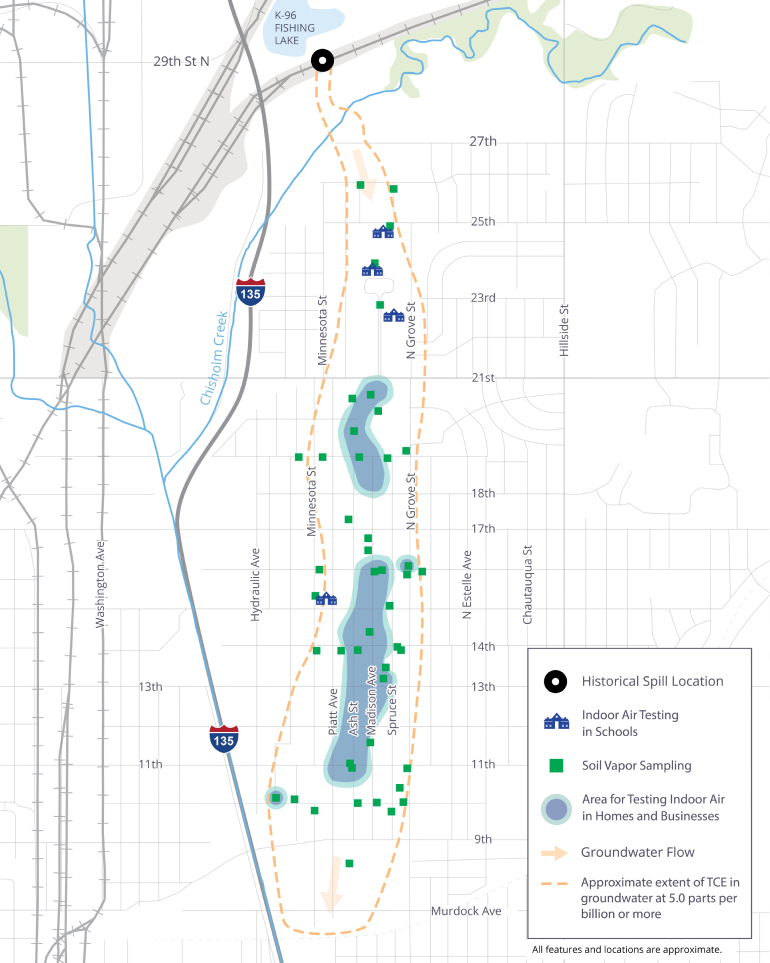Site Timeline and Milestones
Project Map
The 29th and Grove site is situated in the northern section of a Union Pacific Railroad rail yard in Wichita, Kansas, south of K-96 Highway and between I-135 and Grove Street. Contamination at this site was initially identified during investigations ahead of the redevelopment of the 21st Street corridor stretching from I-135 to Grove Street.
Timeline & Milestones
A construction project on 21st Street in Wichita, Kansas, led to the discovery of groundwater contamination.
The possible source of the contamination was identified as a chemical spill at the Union Pacific Railroad yard involving trichloroethylene (TCE). The exact cause and date of the spill are unknown.
Field investigations confirmed contamination at the Wichita rail yard. Union Pacific and the Kansas Department of Health and Environment (KDHE) agreed to investigate the source of the spill and plan a cleanup effort.
A preliminary investigation was completed.
A remedial investigation began to determine the nature and extent of the contamination.
Initial air quality tests were conducted to evaluate the potential for vapor intrusion. This was part of a larger investigation to understand the extent of contamination, called the Remedial Investigation.
Interim remedial actions at the rail yard included installing Accelerated Remediation Technology wells to actively clean up contaminated groundwater, and six groundwater extraction wells designed to prevent the spread of the contaminated groundwater plume. Additional air quality testing for vapor intrusion was conducted in 2009 due to new area construction, which warranted further sampling.
Approximately 1,200 tons of contaminated soil were excavated and removed. During the same period, a technique called In-situ Chemical Oxidation was used, where chemicals were injected directly into the contaminated soil or groundwater to break down pollutants on site, rendering them less harmful.
Additional air quality testing for vapor intrusion was conducted when Kansas updated its safety standards for trichloroethylene (TCE) based on new information from the U.S. Environmental Protection Agency.
Natural cleanup using microbes was employed to naturally break down and remove pollutants from the soil and groundwater, gradually cleansing the area.
A feasibility study is completed to identify and compare additional options for continuing site cleanup.
Public meetings were held at the Boys and Girls Club on May 19 and June 24 to discuss the outcomes of the health study, available community resources, and the next steps for the project.
Remediation activities involved re-evaluating the area for vapor risks, creating a plan for handling contaminated soil, conducting additional groundwater tests, and finalizing a plan for soil vapor testing with the city and community. Additional cleanup of contaminated soil took place in the rail yard, along with surface water testing at Chisholm Creek and continuous monitoring and treatment of the groundwater.
A door-to-door private well survey began in March 2024 in the neighborhood around 29th and Grove. The survey is designed to understand how private wells are being used and promote access to safe drinking water. Indoor vapor intrusion testing began in homes and businesses to determine whether any gases have impacted indoor air quality.
On June 1, as part of its Action for 29th and Grove initiative, Union Pacific held an Open House at the Atwater Neighborhood Resource Center to provide information about ongoing environmental monitoring and cleanup activities.

